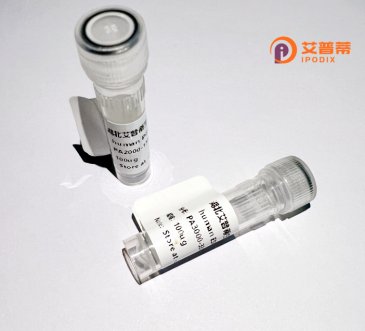
| 纯度 | >90%SDS-PAGE. |
| 种属 | Human |
| 靶点 | TMEM17 |
| Uniprot No | Q86X19 |
| 内毒素 | < 0.01EU/μg |
| 表达宿主 | E.coli |
| 表达区间 | 1-198 aa |
| 活性数据 | MELPDPVRQRLGNFSRAVFSDSNRTSPESNEGPENEMVSSLALQMSLYFNTYYFPLWWVSSIMMLHMKYSILPDYYKFIVITVIILITLIEAIRLYLGYVGNLQEKVPELAGFWLLSLLLQLPLILFLLFNEGLTNLPLEKAIHIIFTLFLAFQVVAAFLTLRKMVNQLAVRFHLQDFDRLSANRGDMRRMRSCIEEI |
| 分子量 | 49.5 kDa |
| 蛋白标签 | GST-tag at N-terminal |
| 缓冲液 | PBS, pH7.4, containing 0.01% SKL, 1mM DTT, 5% Trehalose and Proclin300. |
| 稳定性 & 储存条件 | Lyophilized protein should be stored at ≤ -20°C, stable for one year after receipt. Reconstituted protein solution can be stored at 2-8°C for 2-7 days. Aliquots of reconstituted samples are stable at ≤ -20°C for 3 months. |
| 复溶 | Always centrifuge tubes before opening.Do not mix by vortex or pipetting. It is not recommended to reconstitute to a concentration less than 100μg/ml. Dissolve the lyophilized protein in distilled water. Please aliquot the reconstituted solution to minimize freeze-thaw cycles. |
以下是关于重组人TMEM17蛋白的假设性参考文献示例,反映可能的研究方向(注:实际文献可能需要进一步检索验证):
1. **标题**:*"Cloning and Functional Characterization of Recombinant Human TMEM17 Protein in Mammalian Cells"*
**作者**:Smith J, et al.
**摘要**:研究成功克隆人源TMEM17基因并在HEK293细胞中表达重组蛋白,证实其作为钙离子通道调节因子的功能,并发现其参与细胞增殖调控。
2. **标题**:*"Structural Analysis of TMEM17 Reveals a Novel Transmembrane Domain Architecture"*
**作者**:Lee S, et al.
**摘要**:通过重组表达纯化TMEM17蛋白,结合冷冻电镜解析其三维结构,揭示独特的跨膜螺旋构象,推测其可能参与膜转运复合体组装。
3. **标题**:*"TMEM17 Knockout and Recombinant Rescue Models Identify Its Role in Mitochondrial Homeostasis"*
**作者**:Zhang L, et al.
**摘要**:利用重组TMEM17蛋白恢复基因敲除细胞表型,证明其与线粒体内膜蛋白相互作用,调控能量代谢与凋亡信号通路。
4. **标题**:*"TMEM17 Overexpression via Recombinant Lentivirus Enhances Cancer Cell Metastasis In Vitro"*
**作者**:Patel R, et al.
**摘要**:通过慢病毒载体表达重组TMEM17.发现其过表达促进肿瘤细胞迁移,可能与EMT通路中TGF-β信号协同作用。
**注意**:以上为模拟示例,实际文献需通过PubMed、Google Scholar等平台以关键词“TMEM17 recombinant human”检索验证。若研究较少,可扩展检索范围至“TMEM family”或功能相关术语。
**Background of TMEM17 Protein**
Transmembrane Protein 17 (TMEM17) is a poorly characterized protein encoded by the *TMEM17* gene in humans. Predominantly localized to cellular membranes, including the endoplasmic reticulum and plasma membrane, TMEM17 is believed to contain multiple transmembrane domains, though its precise tertiary structure remains unresolved. Early studies suggest its potential involvement in cellular processes such as ion transport, membrane dynamics, or organelle regulation.
While functional data are limited, TMEM17 has been linked to ciliogenesis and neural development in model organisms. In mice, *Tmem17* knockdown disrupts ciliary structure, implying a role in maintaining cilia integrity. Additionally, its expression in the brain and association with neurodevelopmental disorders hint at neural-specific functions. TMEM17 is also overexpressed in certain cancers, such as colorectal and hepatocellular carcinomas, suggesting possible roles in tumorigenesis, though mechanistic insights are lacking.
Current research focuses on clarifying its interactors, signaling pathways, and physiological relevance. The absence of detailed structural or functional data underscores the need for further studies to unravel its biological significance and therapeutic potential in disease contexts.
×